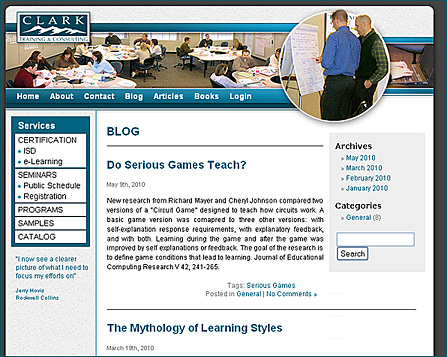I just listened to a presentation by Dr. Ruth Clark entitled, “Efficiency in Learning: Applying Cognitive Load Theory to Distance Learning”. Below are my notes from her presentation.
Besides our long-term memory we have a working memory — which is where the action is and where cognitive load theory focuses
- 7 +- 2 chunks
- George Miller’s work in the 1950’s re: the limitations of working memory
- Cognitive load theory is an update to George’s work
- The concept of “chunking” and the capacity of short term memory. Miller (1956) presented the idea that short-term memory could only hold 5-9 chunks of information (seven plus or minus two) where a chunk is any meaningful unit. A chunk could refer to digits, words, chess positions, or people’s faces. The concept of chunking and the limited capacity of short term memory became a basic element of all subsequent theories of memory.
- So segmenting of content is good – chunking it up — as information should be presented in small digestible units
- A digestible unit of information contains no more than nine separate items of information.
- By chunking information the author improves the reader’s comprehension and ability to access and retrieve the information.
- [Search for items related to “Information Processing Theory” and George Miller for more information]
- Working memory has a limited capacity
- Great for processing – not great for holding information
- Prior knowledge is key here
- Gets slower as trying to hold more information in working memory
- Our challenge as instructional designers is how to optimize cognitive load that maximizes learning
- More complex/difficult subject matter or more novice the learning à more cognitive load
- Intrinsic (imposed by content; how complex is the content?) + Extraneous / Extrinsic (irrelevant & want to minimize this) + Germaine (good stuff; relevant; want to maximize this)
- Intrinsic + extraneous + germaine = additive cognitive load
- Giving learners orientation gives better learning; establish context
- Use audio to explain visuals when appropriate – uses both auditory information track and visual information track
- Modality effect
- Better learning if a visual is explained by words expressed in audio (except if different language)
- Redundancy effect
- Don’t want to use the same text w/ same audio at the same time – less is more – if have a picture of something, with text next to it, plus having someone say that text is too much info – too much cognitive load
- Proximity effect
- Placement of text and visuals
- Keep visuals next to the relevant text/explanation of that visual
- Avoid splitting attention
- Germaine load
- Use examples – but also add self-explanation questions to examples to encourage deeper mental processing and not blowing the example off
- Some more tips
- Watch the pacing of the presented materials
- Provide control to user
- Don’t put items on screen unless serving a purpose
- Don’t put background music if trying to concentrate on learning something
- Motion – careful when use it
- If dealing with experts, don’t have to worry as much about cognitive load burdens; allow control/freedom
- Didn’t sound like Ruth supported learning styles too much – believes that we place too much emphasis on them; prior knowledge is the key according to Ruth
- Some synchronous, web-based communication and collaboration tools can cause cognitive overloads – as the interface can split our attention. We try to absorb information that is flowing at us from the various areas of the interface:
- Chat
- An attendee list of members
- The presentation area/PPTs
- Audio
- Motion w/ application sharing
- etc.
Clark Training & Consulting’s blog –> http://clarktraining.com/blog/









